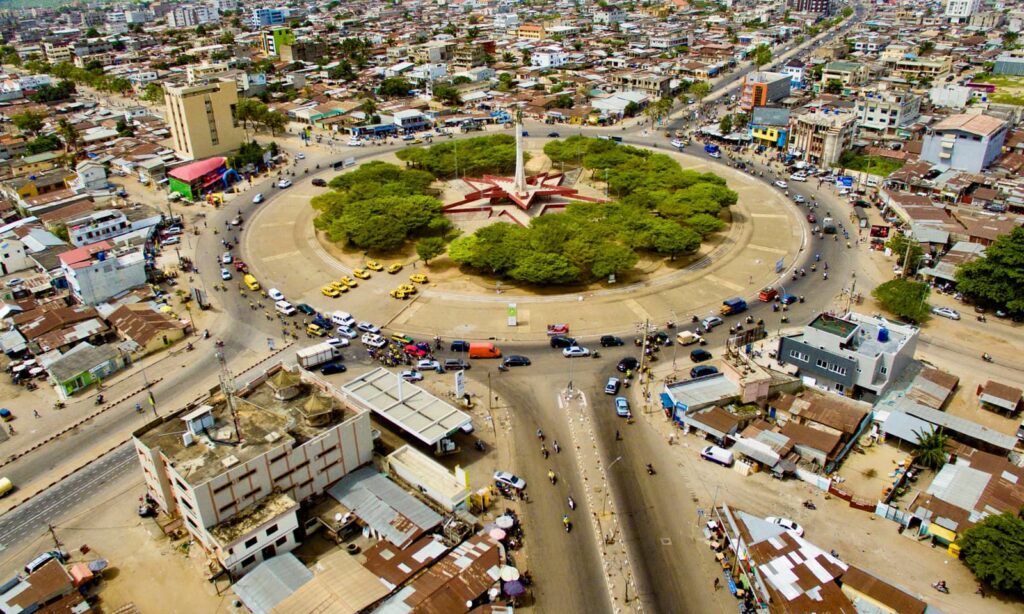
Benin, nestled in West Africa, is a small country rich in fascinating cultural and historical heritage. Covering an area of 114,763 km² and stretching about 700 km, it is bordered by the Atlantic Ocean and shares its borders with Togo, Burkina Faso, and Nigeria. Formerly known as Dahomey, Benin was home to one of the most influential kingdoms in Africa before colonization. Today, it stands out for its ethnic diversity, with over 60 cultural groups. If you’re a travel enthusiast seeking new discoveries, know that Transfergratis, our money transfer app, can truly enhance your experience. With its fast, secure, free transactions and no hidden fees, travelers have the opportunity to book their accommodations before departure from Canada, all at the current exchange rate. So, download the app and discover the five reasons why you absolutely must visit Benin!
1 - The door of no return
Very often, people hesitate to travel and explore the world because they fear running out of money during their stay or not being able to access their funds abroad. This is why the Transfergratis app was developed, to simplify your travels.
One of its main advantages is its convenience. Once you create your account in Canada, even while traveling in Benin, you can continue to make transactions for free, as your account remains active regardless of your location. This allows you to avoid the long queues at traditional agencies and directly pay for the services you want. For example, you can pay for your entrance ticket directly via MTN Mobile Money and visit the famous Door of No Return.
Located in the city of Ouidah, this site is a UNESCO World Heritage site and represents the departure point for 1.2 million Africans who were shipped into slavery during the transatlantic slave trade. This monumental door made of concrete and bronze symbolizes the tragic fate of those who, centuries ago, found themselves at this spot. The decorative frieze facing the ocean depicts chains of enslaved individuals walking on the sand toward a ship whose destination remains unknown to them. On the other side, the door features representations of their hometowns, offering a final glimpse of the ancestral homes they will never see again, for by passing through this door, these enslaved people lost their identity and freedom.
Established by UNESCO in 1995 and renovated in 2021, this site is now a must-visit tourist destination in Benin. Thanks to our app, you can even pay for a tour guide with just one click and delve into the fascinating history of this site.
2 - The Temple of the Pythons
It is a voodoo sanctuary where the worship of the serpent, known as Dangbé, has existed since the late 17th century. This iconic place is home to live sacred pythons, which attract many visitors and are an integral part of the city’s cultural identity. The temple is located in Agoli Square, near a majestic baobab tree in front of the Basilica of the Immaculate Conception, the main Catholic place of worship in the region. Once, the temple grounds spanned several hectares, but urbanization has reduced its size over the years, and it is now situated in the heart of the city.
Originally, the temple was reserved for initiates, but it has evolved over time into a true tourist attraction. Each year, around 1,100 people visit the temple, especially during the holiday season and summer vacations. There is an entrance fee, and it is accessible to everyone. Visitors can even have their picture taken with a python wrapped around their neck.
Each year, the temple generates approximately 5 million CFA francs in revenue, with 10% being allocated by the municipality to support local development.
3 - The Pendjari national park
During your stay, you can take your whole family to explore the Pendjari national park. And if you’re unable to travel, you have the option to send money to your loved ones for a guided tour or even book their excursion to the park directly from Canada.
This protected area is located in the extreme northwest of Benin, within the Atacora department. It encompasses the municipalities of Tanguiéta, Matéri, and Kérou, near the border with Burkina Faso. This park is part of a UNESCO-designated biosphere reserve known as the W-Arly-Pendjari (WAP) complex, which is among Benin’s protected areas. Originally, the park served as a hunting ground for the colonial administration. In 1954, it was declared a partial wildlife reserve, before receiving total reserve status the following year. In 1959, the Pendjari and Atacora hunting zones were established, and in 1961, the wildlife reserve was transformed into a national park.
This park is a true pillar of conservation in West Africa. It is home to approximately 90% of the West African lion population. This wild savannah territory is also a refuge for a multitude of other iconic species, such as endangered cheetahs, as well as elephants, leopards, buffalo, and over 400 species of birds. In 2017, African Parks took over the management of this park in collaboration with the Beninese government. Remarkable initiatives are implemented each year to protect the site while promoting the development of wildlife populations and tourism. The aim is to create sustainable livelihoods for local communities, ensuring that future generations can also benefit from the park’s wealth. If this kind of initiative matters to you, know that with Transfergratis, you can easily support organizations dedicated to protecting the park through donations. What’s truly advantageous is that transactions are completely free, regardless of the amount sent or the number of transfers made. Recipients receive the full intended amount, with no hidden fees.
4 - The royal palaces of Abomey
Far more than mere ruins, they are the guardians of a rich history that dates back to the 17th century when the Kingdom of Dahomey, founded by Houegbadja, began to thrive. Between 1625 and 1900, twelve kings ruled over this kingdom, transforming it into one of the greatest powers on the West African coast.
Covering 47 hectares, the site of the royal palaces is a true architectural treasure made up of ten palaces, some adjacent and others stacked. These palaces, built according to the principles of Aja-Fon culture, were the nerve center of the kingdom, where decisions were made and remarkable artisan techniques were developed. They also housed the treasures of the kingdom, making this place a symbol of the wealth and creativity of its inhabitants.
The site is divided into two distinct areas: the palaces of King Akaba and his father, Houegbadja. Each palace features a harmonious layout with several courtyards: outer, inner, and private. The use of traditional materials and the beautiful polychrome bas-reliefs add a touch of elegance to this unique architecture. Although the palaces are no longer inhabited, those of King Ghézo and King Glèlè now house the historical museum of Abomey. A guided tour allows you to dive into the fascinating history of the kingdom, revealing its spirit of independence, resistance, and struggle against colonial occupation. By visiting the royal palaces of Abomey, you will not only discover a historical site but also feel the vibrant soul of a kingdom
5 - The Ouidah history museum
If you are a lover of tales and legends, this destination is made for you.
Located in the former Portuguese fort São João Batista de Ajuda and built in 1721, this museum stands as a witness to the historical exchanges between local cultures. As you pass through its doors, you are welcomed by an atmosphere rich in history. With its 700 collection pieces, the museum invites you on a fascinating journey through time. You will discover archaeological objects that speak of the ancient civilizations of the region, as well as artifacts illustrating the tumultuous history of Ouidah, a port of cultural and commercial exchanges. The museum is not limited to written history; it is also a space that celebrates local art. The exhibited works highlight the talent and creativity of the region’s artists, allowing you to appreciate the diversity and richness of Beninese culture. Each piece tells a story, a tradition, an emotion, making your visit even more immersive and meaningful. You can even support the museum by making instant purchases in the souvenir shop using your app or directly from the Transfergratis website.
In summary, Transfergratis is an app that allows you to make free transactions from Canada to Benin, with no hidden fees and at the current exchange rate. You can book your hotel before you leave, pay for your entrance tickets to tourist sites, settle your restaurant bills, or shop at the supermarket without worrying about transfer fees, delays, or the amount sent. Transfers are instant, secure, and customer service is available 24/7 to answer all your questions. Moreover, your beneficiaries receive funds directly on MTN Mobile Money, avoiding long lines and paperwork from agencies. So, download the app now and enjoy a stress-free stay.
Feel free to share this article with your loved ones in Benin and check out our blog to discover all the wonderful tourist attractions in Africa!







